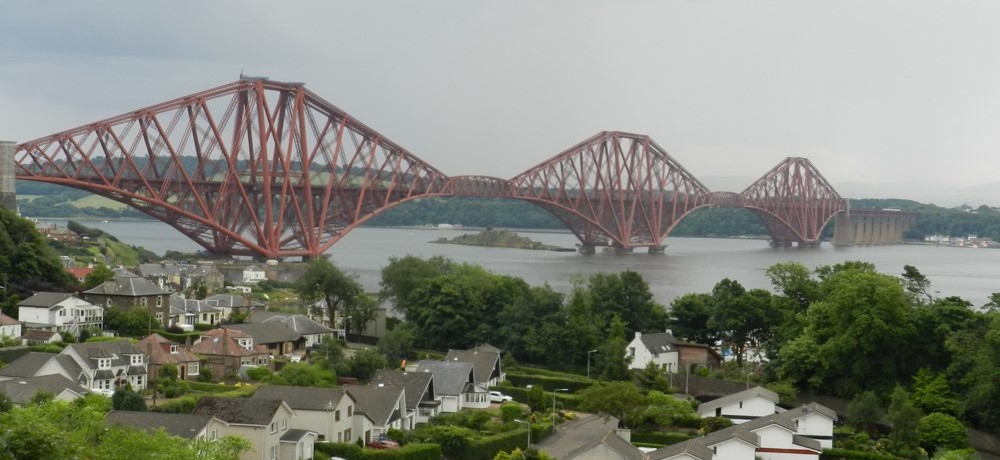Fulfilling a promise, the author retraces his grandfather’s route from 75 years prior
My grandfather, born in 1920, was a proud Scotsman who served in the Second World War as an RAF Lancaster pilot. He did have some good stories, and as many people do as they age, he told them repeatedly. When he would visit my Southern Ontario home, he’d see my prized 1967 Triumph Bonneville on display in the corner of my living room, and this would prompt him to recount my favourite story. A tale of a trip he took circumnavigating the Isle on a “flat tank AJS 500” in 1938, before enlisting in the air force – a “one last blast” type of affair before his life’s duties. I always listened closely, as each time he told the story, a new detail was revealed. He was pleased when I told him that one day I would retrace this trip on a motorcycle.
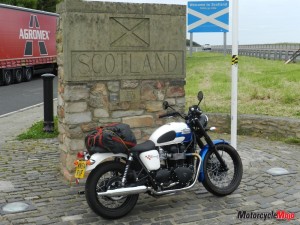 When I knew his time was nearing the end, I bought a detailed map of Great Britain and asked him to highlight the route of his fabled trip for me. He was pleased to do so, and with the completed map, he also provided an accompanying booklet of notes that included places of importance and some of his experiences along the way.
When I knew his time was nearing the end, I bought a detailed map of Great Britain and asked him to highlight the route of his fabled trip for me. He was pleased to do so, and with the completed map, he also provided an accompanying booklet of notes that included places of importance and some of his experiences along the way.
When he passed on near the end of that year, and my grandmother shortly thereafter, I knew then I would make good on this promise. With the blessing of my mother, I would bring the remains of both my grandparents (John and Vera Bill) back to their homeland and provide a final resting place for them. It seemed fitting that I would ceremoniously scatter their ashes off the Firth of Forth Bridge near Edinburgh. The current of the Forth River would take them to the North Sea.
Triumph Motorcycles Canada was kind enough to arrange a very special motorcycle for this important ride – a 2015 Bonneville T214. The T214 is a limited edition bike with vibrant white and blue paintwork with red accents. It commemorates the world land speed record Triumph set in 1956 with Johnny Allen aboard hitting a remarkable 214 mph.
The Trip Begins
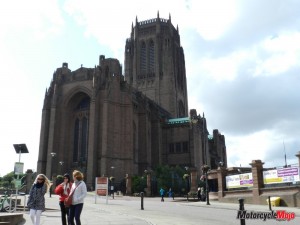 I kept the ashes in a satchel that I held with me at all times and they passed through customs security with only minimal questioning. Because of flight transfers and airport layovers, I only had about 30 minutes of sleep in the last day and a half. Not the best way to begin riding in a foreign land where they drive on the opposite side of the road with roundabouts that can spit you off in the wrong direction with ease if you’re not paying very close attention.
I kept the ashes in a satchel that I held with me at all times and they passed through customs security with only minimal questioning. Because of flight transfers and airport layovers, I only had about 30 minutes of sleep in the last day and a half. Not the best way to begin riding in a foreign land where they drive on the opposite side of the road with roundabouts that can spit you off in the wrong direction with ease if you’re not paying very close attention.
Picking up the bike at the Triumph factory in Hinckley, Leicester, England, I loaded it up and was soon off on my journey into the past dressed in vintage riding gear comprising my lace-up leather boots, jeans, open-face helmet with goggles, gauntlet gloves, leather biker jacket and my trusty silk scarf. Once underway, the reality set in that I was embarking on a week in a foreign country without hotel reservations and my only navigational aid was my pop’s map with a route drawn on it.
I rode about the small town of Hinckley until I saw signs indicating south, and then spent at least three hours bumbling about small villages and back roads until finally getting my bearings and venturing onto the M1 to London.
My goal for the first day was to get to London by nightfall and meet up with my old friend Paul, who had moved there a number of years ago to pursue his career as an artist. He would set me straight on dos and don’ts and how to get around as it relates to motorcycle travel.
Paul’s advice proved invaluable. He instructed me with great enthusiasm about the thousands of traffic cameras used to enforce not just speed, but all manner of traffic laws. It was critical to know when you could ride in the bus lane and when not to. His seriousness about all these points became obvious when he pulled out a large file of past infractions he had accumulated after he moved to Britain. There were plenty of photos of Paul on his SV650 violating numerous minor laws. “They managed to vacuum all the money out of my bank account in those first few months.”
The next morning was a quick tour of the notable points one must see in London – Buckingham Palace, Soho, Piccadilly Circus, London Bridge – all while Paul weaved through traffic pointing to the cameras. It would have taken days to see what he showed me in one morning. Grateful for the tour and instruction, I picked up my grandfather’s route after Paul escorted me to the north end of the city.
Time Traveller
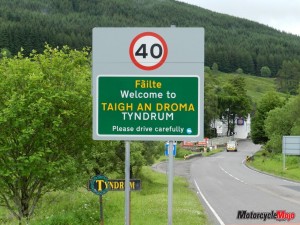 I left London on the M1, a six-lane highway with heavy traffic and a 70 mph speed limit. I know most motorcyclists would scoff at the thought of riding along what is likely the most travelled motorway in Britain instead of the many curving country roads, but the route had been determined and I would follow it back in time. The Bonnie purred away nicely at this speed through England’s heartland of industry. Cities like Nottingham, Sheffield and Leeds were fundamental in the beginnings of the Industrial Revolution and still remain as the manufacturing centres of the country. It was at this point that I first thought about how much my prescribed route has changed in the past 75 years and that an AJS 500 single would not be able to live on today’s M1.
I left London on the M1, a six-lane highway with heavy traffic and a 70 mph speed limit. I know most motorcyclists would scoff at the thought of riding along what is likely the most travelled motorway in Britain instead of the many curving country roads, but the route had been determined and I would follow it back in time. The Bonnie purred away nicely at this speed through England’s heartland of industry. Cities like Nottingham, Sheffield and Leeds were fundamental in the beginnings of the Industrial Revolution and still remain as the manufacturing centres of the country. It was at this point that I first thought about how much my prescribed route has changed in the past 75 years and that an AJS 500 single would not be able to live on today’s M1.
Newcastle was to be my destination that evening. Pop’s notes advised that it was quite the party town with an active nightlife. I rode straight to the city centre before beginning to look for accommodations. A mishmash of twisting one-way streets made the task of finding a hotel very frustrating, especially after a tiring 300-mile day. After getting settled in an overpriced downtown establishment, I was off to see the sights I had read about in the notebook.
A Saturday night in Newcastle is like Mardi Gras. It seems that there is no special occasion, however: just hordes of people on the streets living it up. I found out later that Newcastle is a destination for many Europeans with cause to celebrate. I’m not certain if this was the case back in the 1930s, but Pop knew something about it.
As I was packing up the following morning, I was not only determined to get into Scotland that day, but also to fulfill my mission to release the ashes off the bridge at the Firth of Forth. The task was weighing heavily on me by this point, both figuratively and literally. The 13 kg satchel hanging off my neck was getting quite uncomfortable. This was an achievable goal, as it was only 150 miles to the bridge near Edinburgh, even with smaller roads to follow. I wanted to take a brief jaunt off my route to see Hadrian’s Wall, the Roman wall built almost 1000 years ago to protect the Empire from the “barbarians” to the north. I explored small villages along the eastern end of the wall and found it interesting how the local residents incorporated this historic structure into their yards and crop fields.
Scotland greeted me at its border with overcast skies and the beginnings of rain. I pressed on to ensure I would be at the bridge before any significant inclement weather began. I was awestruck by the beauty of old Edinburgh. The architecture is astounding; streets are lined with impeccably maintained historical buildings accented by brightly coloured trim work and gold gilding. All this, and a castle in the middle of the city. Pop’s notes indicated that it was “quite fancy” near the Royal Palace, but I really had no idea this city held such treasures. I would love to have stayed in the city for the afternoon, but the skies looked threatening and the satchel continued to weigh heavily around my neck.
Ashes to Ashes
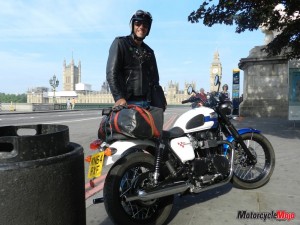 As I approached the Forth River Bridge, I was taken aback by its enormity. I thought it would take quite some time to walk to the centre, as stopping midway on the Triumph was not an option. With the bike parked on the lay-by and my satchel in hand, I started the long walk along the bridge as the heavy mist turned into rain. A sick feeling hit me as I read a warning sign advising it was illegal to throw any item from the bridge. It further stated that the area was under close video surveillance and violators will be prosecuted. But I travelled so far. How could I not have known this? I suppose the answer to that is quite simple: I never researched any of this. For all I knew, the bridge could have been closed to pedestrian traffic. I felt like an idiot and the rain came down with greater intensity.
As I approached the Forth River Bridge, I was taken aback by its enormity. I thought it would take quite some time to walk to the centre, as stopping midway on the Triumph was not an option. With the bike parked on the lay-by and my satchel in hand, I started the long walk along the bridge as the heavy mist turned into rain. A sick feeling hit me as I read a warning sign advising it was illegal to throw any item from the bridge. It further stated that the area was under close video surveillance and violators will be prosecuted. But I travelled so far. How could I not have known this? I suppose the answer to that is quite simple: I never researched any of this. For all I knew, the bridge could have been closed to pedestrian traffic. I felt like an idiot and the rain came down with greater intensity.
I looked off the bridge toward the North Sea. Below me were riverfront estates and a marina. I decided to head down to the pier and have my “ceremony”
there. I quickly convinced myself that this was a better idea anyway.
I had a quiet moment with Nan and Pop and then set them off to the North Sea. As corny as it sounds, at that moment, the rain stopped and a patch of sun appeared above the river. In my head I could hear Pop say, “Good job, son.”
The rain came back with ferocity as the Bonnie and I travelled north on A92, but with the weight lifted from my shoulders, I was able to continue on until dark. That night, I celebrated my personal achievement with some locals at the Robbie Burns Lounge in downtown Perth. Even on a Sunday night, those locals know how to have a good time.
The following morning was warm and sunny, which made it reassuring that I could reach my intended destination of Inverness that evening. It is only 200 miles in distance, but on small, twisting and turning coastal roads with much lower speed limits, it would likely take all day.
The Honours of Scotland
High atop the rocky cliffs on the outskirts of Aberdeen sits the ancient remains of Dunnottar Castle. This centuries-old fortress embodies the rich history of the land, as it was home for such notable Scots as William Wallace, King Charles II and Mary Queen of Scots. It’s also well known for having protected the Scottish crown jewels from invading armies. The crown, sceptre and sword now rest in Edinburgh Castle.
The country road that leads to Inverness in the Highlands travels inland through lush evergreen forests, occasionally opening up to rolling pastures complete with the herds of sheep you would expect. As elevations increased, the temperature dropped and rain began again. I rolled into the ancient city at the end of my day’s ride cold and wet, as I did the day before.
Ale, Haggis and History
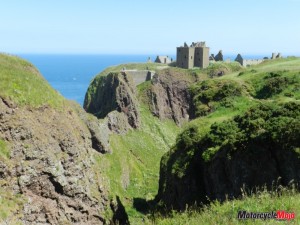 I called up an old friend whom I had worked with organizing the Canadian round of the 2006 World Enduro Championship, held in Parry Sound, Ontario. Lindsay had moved to Scotland some years ago and settled in well with her husband, Mark. They generously offered up a nourishing meal, complete with local ale and haggis. Mark is a bit of a history buff such as myself, so I was entertained by his encyclopedic knowledge of the area and its notable past. He regaled me with stories of the Great Glen, Loch Ness, Highland government structure and the Thomas Telford-engineered Caledonian Canal, which runs from Fort William in the southwest to Inverness in the northeast. The canal system, built over 200 years ago, is another marvel of Scottish engineering known as world leading at the time.
I called up an old friend whom I had worked with organizing the Canadian round of the 2006 World Enduro Championship, held in Parry Sound, Ontario. Lindsay had moved to Scotland some years ago and settled in well with her husband, Mark. They generously offered up a nourishing meal, complete with local ale and haggis. Mark is a bit of a history buff such as myself, so I was entertained by his encyclopedic knowledge of the area and its notable past. He regaled me with stories of the Great Glen, Loch Ness, Highland government structure and the Thomas Telford-engineered Caledonian Canal, which runs from Fort William in the southwest to Inverness in the northeast. The canal system, built over 200 years ago, is another marvel of Scottish engineering known as world leading at the time.
The next morning came fast and a steady downpour provided the backdrop as I rode south to Glasgow. Running down the Great Glen, A82 hugs the shore of Loch Ness, home to the monster known affectionately as “Nessie” to the locals. The rain and fog added to the eerie feeling the famous loch emits. A coffee stop to warm up was required not long after setting off, and I left my leather gloves on the engine to hopefully dry a bit and warm up.
Many world travellers know the section of A82 from Inverness to Glasgow as the most picturesque roadway in the U.K. Although the low-hanging clouds restricted visibility, there was still no shortage of breathtaking views.
The Real Experience
I stopped for fuel in a mountain village with an unpronounceable Gaelic name. I waited in line for the pump behind a large group of German motorcycle travellers on big BMW touring bikes. They looked at me a bit funny, as I was absolutely drenched to the bone and trying not to shiver too much. They stood together in their fancy, colour-coordinated Gore-Tex outfits, their bikes equipped with such luxurious accessories as heated grips and windscreens. Although I felt a degree of envy at that moment, I just tried to tell myself that they were missing the “real experience.” Once done refuelling, I shrugged off their indecipherable comments, pulled my silk scarf up high on my face, adjusted my goggles and roared off, trying to look as cool as I possibly could.
Although I experienced some of the best roads I have ever travelled combined with spectacular scenery and rich history, I was glad to roll into Glasgow. After such a day of endurance, I thought I would treat myself to a nice hotel and dinner right downtown. The city presented itself as multicultural with an obvious arts community, along with high fashion and many expensive sports cars driving about. I rode into the heart of town feeling pretty fashionable myself, mounted on a startlingly beautiful modern classic Triumph. After a couple of unsuccessful attempts at obtaining accommodations I was becoming quite disillusioned, and in my soggy state, I was losing patience. One hotel clerk, noticing my frustration, was kind enough to find something close by – only 290 pound sterling (CDN$575) a night! Suffice to say, I hit the road out of this very nice town.
A bit farther down the road, I saw the signs to my mother’s hometown, aptly named Motherwell. Indeed, she was from this small village referenced in detail in Pop’s notes. Being far enough away from the extravagance of Glasgow, it was easy to find an affordable room here. I stayed on the outskirts of town and made plans come morning to find the house in which my mother was born.
A Canadian Looking for His Roots
I found the house with ease and parked out front to take a picture or two to send to my mom. It was a quiet middle-class neighbourhood that I doubt had changed much since the late 1940s, when my mom arrived on the scene. Before taking the photos, though, I knocked on the door so as not to cause concern to the present-day occupant. The door was not answered, but instead a lady poked her head out of the second-storey window and asked what I wanted. When I explained that I came from Canada to retrace some of my family’s history and was hoping to take a photograph, her demeanor changed immediately and I was invited for a tour of the backyard and beyond. I heard her shouting to her children about a Canadian on a motorcycle as I rode off. My mission this day was to get to Liverpool, but I had little time to waste if I was to stay on Pop’s prescribed route.
Constant reminders of photo radar and “speed regulating zones” kept me in accordance with the law as I crossed back into England. After stopping for a customary lunch of fish and chips with mushy peas in Carlisle, which is at the west end of Hadrian’s Wall, I visited the local Triumph dealer to look around and pick up a souvenir or two. I was quickly welcomed by the owner and treated first class. I mentioned I was retracing a 75-year-old journey and had been at the other end of Hadrian’s Wall two days earlier but took the long way here through the north end of Scotland. Folks remarked that the limited edition T214 Bonneville was a spectacular motorcycle, but hardly the right piece to ride on such a journey. When I told them my grandfather did it on an AJS 500 single, they laughed and admitted the new Bonnie was a luxury touring machine by comparison.
I veered off the M6 to ride the coastal road to Blackpool, a place where my notes say Pop stayed the night and tasted oysters for the first time. Then it was onward to Preston and Southport, where the cold wind blowing off the Irish Sea reminded me once again of my improper choice of clothing. Pop’s notes describe a “fancy red blazer with brass buttons” that he wore on his trip, which would seem much less appropriate than my choice of attire. Home of the Fab Four I finally rolled into the port city of Liverpool as the sun was setting. You can’t even think of this city without conjuring up thoughts of the Fab Four, a band that would not exist for another 25 years after Pop’s AJS sputtered through town. There was so much to see, but precious little time. I needed to be back at the Triumph factory by the end of the next day, so that night in my hotel room, I decided on what I would see in the morning before heading east and back to Hinckley.
Remembering how difficult it was to find my way around the country roads of Leicester, I had to allow extra time to make sure I caught the factory before closing, as it was a decent distance that required some odd rural navigation. By morning, I knew how to spend my brief time in Liverpool. After a quick visit to the docks at the River Mersey, I quickly ripped up from the riverside to view the monolithic Liverpool Anglican Cathedral, one of the largest in the world. Then, after much research, I was able to find the coordinates of the boyhood home of the great Ringo Starr; being a drummer my whole life, it only made sense to visit the early residence of the most influential drummer of all time. This humble flat is not even located on a street, but merely an alley, making it that much more difficult to find. I walked up the quiet cobblestone way and snapped a few photos. I recognized the row of houses from the movie Hard Day’s Night, only then the alley was filled with screaming teenage girls. Promise Fulfilled Only 150 miles were needed that day. Liverpool through Manchester and Birmingham, and then it was off the main road toward Hinckley, “Home of Triumph,” as the sign reads.
I impressed myself by finding the way directly to my destination without even looking at a map. In my week’s voyage, I had learned to read the road and follow the roundabout directions. It was a great victory for me as I recalled only a few days earlier when it took hours just to get out of town, never mind find my way to London. In the taxi back to the airport, I reflected on what I had done, where I had been, and I thought of my grandparents. The Bonneville T214 performed the task of being my “British Time Machine” flawlessly. Although what I saw and experienced on this pilgrimage was much different than what Pop had seen back in 1938, a connection of sorts was made. All his stories were different now.









